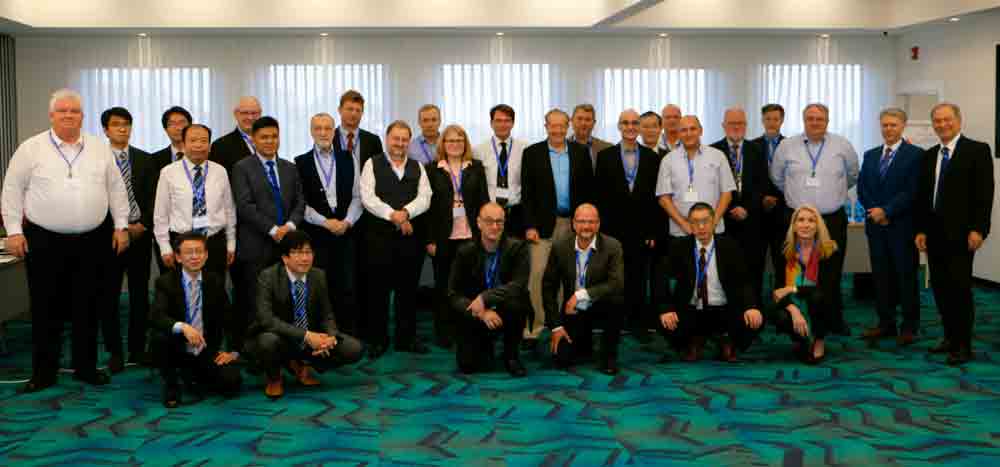The Holy Land Is the Setting for ISO Meetings
Aug 1, 2017

International Organization for Standardization (ISO) WG 4, WG 6 gatherings delve into coming changes to elevator stan
By worldwide standards, Israel is a very small country, both in geographical area and in population, but its impact on the world has been enormous in many ways. Since its creation 69 years ago, the State of Israel has held the world’s attention to an extent unparalleled by any country of its size. Much of this attention is, of course, related to the perennial tension and frequent conflict that engulfs the Middle East. The impact of Israel on the world stage is, however, much broader and deeper than what the news headlines often portray. Israel is a complex blend of ancient and modern history, sacred sites and secular venues, traditional culture and ultra-modernity.
It is against this backdrop that several meetings on international standards were held on March 27-31. The dynamic nature of Israel’s building industry, and the consequent demand for elevators, has fostered a strong interest in elevator safety standards. Israel has been a Participating Member (P-Member) of ISO/TC 178 for many years, and it is encouraging that the Standards Institution of Israel invited ISO/TC Working Groups (WGs) 4 and 6 to hold meetings in Israel for the second time (the first being in November 2015). The meetings took place at the Kfar Maccabiah Convention Center in Ramat Gan, near Tel Aviv, and were held in conjunction with two other gatherings: the fifth Israeli Convention for Standardization and Engineering of Elevators, and a meeting of the European Committee for Standardization AH 17 advisory group. (See article immediately following.)
David McColl, Convenor of WG 4, opened the meeting by introducing Revital Maor, international standards coordinator of the Standards Institution of Israel (SII). Maor said she was delighted to welcome the international group of experts to Israel, adding that Israel’s role in hosting the meetings confirms its support for international standards. Maor thanked Eng. Michael Swisa, head of the Lifts and Lifting Devices Section, SII, for organizing the meetings.
Swisa then spoke, welcoming the delegates and outlining the week’s activities for the expected 300 attendees.
McColl added his welcome, noting the presences of WG 4 representatives from 13 countries, as well as a liaison representative from the Pacific Asia Lift and Escalator Association. He updated the WG on activities since the last meeting and called upon the various task-group chairs to report on specific work items.
Task Force on Risk Assessment (TFRA)
Your author chairs the TFRA and reported on the progress being made in revising the ISO 14798 Risk Assessment Methodology. This standard is used on a worldwide basis and has been found to be particularly useful in the implementation of performance-based codes for innovative products. The methodology is being updated to ensure it remains consistent with the state of the art and include more examples to assist in utilizing this document. To this end, a user-friendly guide is being developed to help explain the utilization of the standard with the aid of pertinent examples. A multinational team has been established and tasked with addressing these issues.
Task Force on Conformity Assessment (TFCA)
Stephan Stoermer of the Austrian Standards Institute chairs the TFCA and reported on the progress made in revising ISO 8100-22 and -23 (formerly ISO TS 22559-3 and -4), which relate to the establishment and roles of Global Conformity Assessment Bodies (GCABs). It is important that GCABs be accredited to provide product certification on a global scale. To this end, the documents are being revised to make them more suitable for worldwide use and to better describe the accreditation and role of the GCABs.
Task Force on Convergence (TFC)
McColl chairs the TFC and reported on the progress made in creating an ISO prescriptive standard based on EN 81-20/-50. The proposed documents comprise three parts: ISO 8100-1, -2 and -3. Parts 1 and 2 will be identical to EN 81-20 and -50, respectively. Part 3 is aimed at assisting users of parts 1 and 2 to identify requirements in ASME A17.1/CSA B44 and relevant Japanese standards, which need to be addressed in addition to — or in lieu of — requirements in parts 1 and 2. The proposal was balloted to the P-Members of ISO/TC 178, and the comments received were addressed and technical changes to the documents proposed to support valid comments.
The revised documents were discussed, and it was agreed that the documents would be submitted for the next stage of ISO approval by the member countries of TC 178.
ISO/TC 178 WG 6 Meeting
Ari Ketonen, convenor of WG 6, outlined the activities of his group. He called upon the chairs of the various study groups to update the WG on their activities.
Study Group on Lift Dimensions (SG 1)
Ian Jones, representing the British Standards Institute, reported on behalf of SG 1. ISO 8100-30 (formerly ISO 4190-1) has been revised to include dimensional updates and reference to machine-room-less lifts. A draft international standard has been balloted to ISO/TC 178 P-Members.
Study Group on Planning and Selection (SG 5)
Dr. Marja-Liisa Siikonen, chair of SG 5, updated WG 6 on the status of ISO TS 8100-32 (formerly ISO 4190-6) on planning and selection of passenger lifts to be installed in office, hotel and residential buildings, a standard that has not been technically revised for many years. In earlier times, the elevatoring of buildings was based on “up-peak” analysis equations, which determined service-interval and handling-capacity values. If these values were within recommended criteria, the elevatoring of the building was considered adequate. With the advent of microprocessor-based operational control systems, sophisticated traffic-management strategies have become feasible. The performance of such systems can be evaluated using computer-based simulation programs. Moreover, it is now possible to monitor the performance of elevator installations in situ — in actual buildings.
The proposed standard provides two methods of evaluating the suitability of a particular elevator arrangement in a given building. The methods are the calculation method, which is useful for relatively simple installations, and the simulation method, which is useful for complex situations.
WG 6 discussed the various aspects of the proposed standard and agreed to forward it for ballot to ISO/TC 178 members.
Study Group on Seismic Conditions (SG 6)
Goetz Metzdorf, chair of SG 6, updated WG 6 on the status of the revision of the ISO/TR 25741 (lifts and escalators subject to seismic conditions) compilation report. This technical report was published in 2008 and is due for renewal in accord with worldwide changes to seismic standards. The original document provided information on seismic requirements in North America, Japan and New Zealand. Since then, the original standards have been updated, and major work has focused on developing European standards for elevators and escalators. Experts from around the world have volunteered to serve on SG 6 to create an updated version of ISO/TR 25741.
Following this update, your author provided an update on North American seismic standards — in particular, how A17.1/B44 requirements have been aligned with the American Society of Civil Engineers 7 requirements. Because of the complex nature of the requirements, a guide, TR A17.1-8.4 for elevators, has been published, and guide TR A17.1-8.5 is being developed for escalators.
Takeshi Miyata of the Japan Elevator Association updated WG 6 on the changes to Japanese seismic requirements. These were partly in response to the Fukushima Daiichi nuclear accident, which resulted from the tsunami following the Tōhoku, Japan, earthquake on March 11, 2011. The Japanese requirements are very comprehensive and will add significantly to the value of ISO/TR 25741.
Get more of Elevator World. Sign up for our free e-newsletter.







